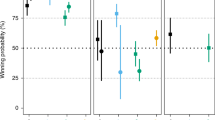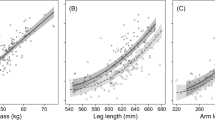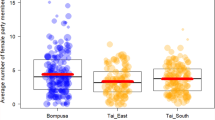Abstract
Bonobos have a reputation as a female-dominated and egalitarian species. We examined the 2 aspects of dominance in 6 captive bonobo groups. Females do not consistently evoke submission from all males in all contexts. Though females occupy the highest-ranking positions in the dominance hierarchy, there are in each group males that obtain rather high ranks and are able to dominate ≥1 female. Thus female dominance is not complete and hierarchies can be better described as nonexclusive female dominance. We studied egalitarianism by measuring linearity and steepness of dominance hierarchies. The hierarchies of all groups are highly linear. Hierarchies among males are steeper than among females. On average, male bonobos are more despotic than females, but females too can have despotic relations, both with other females and with males. Hence one can call bonobos in captivity semidespotic rather than egalitarian.


Similar content being viewed by others
References
Altmann, J. (1974). Observational study of behavior: Sampling methods. Behaviour, 49, 227–267.
Appleby, M. C. (1983). The probability of linearity in hierarchies. Animal Behaviour, 31, 600–608.
Boehm, C. (1999). Hierarchy in the forest: The evolution of egalitarian behavior. Cambridge, MA: Harvard University Press.
Clutton-Brock, T. H., Albon, S. D., Gibson, R. M., & Guinness, F. E. (1979). The logical stag: Adaptive aspects of fighting in red deer (Cervus elaphus L.). Animal Behaviour, 27, 211–225.
David, H. A. (1988). Ranking from unbalanced paired-comparison data. Biometrika, 74, 432–436.
de Vries, H. (1995). An improved test of linearity in dominance hierarchies containing unknown or tied relationships. Animal Behaviour, 50, 1375–1389.
de Vries, H. (1998). Finding a dominance order most consistent with a linear hierarchy: A new procedure and review. Animal Behaviour, 55, 827–843.
de Vries, H., Netto, W. J., & Hanegraaf, P. L. H. (1993). Matman: A program for the analysis of sociometric matrices and behavioural transition matrices. Behaviour, 125, 157–175.
de Vries, H., Stevens, J. M. G., & Vervaecke, H. (2006). Measuring and testing steepness of dominance hierarchies . Animal Behaviour, 71, 585–592.
de Waal, F. B. M. (1988). The communicative repertoire of captive bonobos (Pan paniscus) compared to that of chimpanzees. Behaviour, 106, 183–251.
de Waal, F. B. M. (1989). Dominance ‘style’ and primate social organization. In V. Standen & R. Foley (Eds.), Comparative socioecology. The behavioural ecology of humans and other mammals (pp. 243–264). Oxford: Blackwell Scientific Publications.
de Waal, F. B. M. (1994). Chimpanzee’s adaptive potential. In R. W. Wrangham, W. C. McGrew, F. B. M. de Waal, & P. G. Heltne (Eds.), Chimpanzee cultures (pp. 243–260). Cambridge, MA and London: Harvard University Press.
de Waal, F. B. M. (1996). Conflict as negotiation. In W. C. McGrew, L. A. Marchant, & T. Nishida (Eds.), Great ape societies (pp. 159–172). Cambridge, UK: Cambridge University Press.
de Waal, F. (1997). Bonobo, The forgotten ape. Berkeley and Los Angeles: University of California Press.
Drea, C. M., & Frank, L. G. (2003). The Social Complexity of Spotted Hyenas. In F. B. M. de Waal & P. L. Tyack (Eds.), Animal social complexity: Intelligence, culture and individualised societies (pp. 121–148). Cambridge, MA: Harvard University Press.
Flack, J. C., & de Waal, F. B. M. (2004). Dominance style, social power, and conflict management in macaque societies: A conceptual framework. In B. Thierry, B. Chapais, W. Kaumanns, & M. Singh (Eds.), How societies are built: The macaque model (pp. 157–182). Cambridge, UK: Cambridge University Press.
Fruth, B., Hohmann, G., & McGrew, W. C. (1999). The Pan species. In P. Dolhinow & A. Fuentes (Eds.), The nonhuman primates (pp. 64–72). London: Mayfield Publishing Company.
Furuichi, T. (1997). Agonistic interactions and matrifocal dominance rank of wild bonobos (Pan paniscus) at Wamba. Folia Primatologica, 18, 855–875.
Furuichi, T., & Hashimoto, C. (2004). Sex differences in copulation attempts in wild bonobos at Wamba. Primates, 45, 59–62.
Gammell, M. P., De Vries, H., Jennings, D. J., Carlin, C. M., & Hayden, T. J. (2003). David’s score: A more appropriate dominance ranking method than Clutton-Brock et al.’s index. Animal Behaviour, 66, 601–605.
Gold, K. C. (2001). Group formation in captive bonobos: Sex as a bonding strategy. In The apes: Challenges for 21st century (pp. 90–93). Brookfield: Brookfield Zoo.
Goodall, J. (1986). The chimpanzees of Gombe: Patterns of behaviour. Cambridge, UK: Campbridge University Press.
Haas, G. (1983). Neue Menschenaffenanlage im Zoo Wuppertal. Der Zoologischer Garten Neue Folgung, 53, 93–101.
Hand, J. L. (1986). Resolution of social conflicts: dominance, egalitarianism, spheres of dominance and game theory. Quarterly Review of Biology, 61, 201–220.
Kano, T. (1992). The last ape: Pygmy chimpanzee behavior and ecology. Stanford CA: Stanford University Press.
Kano, T. (1996). Male rank order and copulation rate in a unit-group of bonobos at Wamba, Zaïre. In W. C. McGrew, L. A. Marchant, & T. Nishida (Eds.), Great ape societies, (pp. 135–145). Cambridge, UK: Cambridge University Press.
Kappeler, P. M. (1990). Female dominance in Lemur catta: More than just female feeding priority? Folia Primatologica, 55, 92–95.
Kappeler, P. M. (1993). Female dominance in primates and other mammals. In P. G. Bateson, P. H. Klopfer, & N. S. Thompson (Eds.), Perspectives in Ethology: Vol. 10: Behavior and evolution. (pp. 143–158). New York: Plenum Press.
Kuroda, S. (1980). Social behavior of pygmy chimpanzees. Primates, 21, 181–197.
Marvan, R., Stevens, J. M. G., Roeder, A. D., Mazura, I., Bruford, M. W., & de Ruiter, J. R. (2006) Male dominance rank, mating and reproductive success in captive bonobos (Pan paniscus). Folia Primatologica, 77, 364–376.
Palagi, E., Paoli, T., & Tarli, S. B. (2004). Reconciliation and consolation in captive bonobos (Pan paniscus). American Journal of Primatology, 62, 15–30.
Parish, A. R. (1996). Female relationships in bonobos (Pan paniscus). Human Nature, 7, 61–96.
Parish, A. R., & de Waal, F. B. M. (2000). The other “closest living relative”: How bonobos (Pan paniscus) challenge traditional assumptions about females, dominance, intra- and intersexual interactions, and hominid evolution. Annals of the New York Academy of Sciences, 907, 97–113.
Pereira, M. E., Kaufman, R., Kappeler, P. M., & Overdorff, D. J. (1990). Female dominance does not characterize all of the Lemuridae. Folia Primatologica, 55, 96–103.
Pochron, S. T., Fitzgerald, J., Gilber, C. C., Lawrence, D., Grgas, M., Rakotonirina, G., et al. (2003). Patterns of female dominance in Propithecus diadema edwardsi of Ranomafana National Park, Madagascar. American Journal of Primatology, 61, 173–185.
Smuts, B. B., & Smuts, R. W. (1993). Male aggression and sexual coercion of females in nonhuman primates and other mammals: Evidence and theoretical implications. Advances in the Study of Behavior, 22, 1–63.
Stanford, C. B. (1998). The social behavior of chimpanzees and bonobos. Current Anthropology, 39, 399–420.
Stevens, J. M. G., Vervaecke, H., de Vries, H., & Van Elsacker, L. (2005). The influence of steepness of dominance hierarchies on reciprocity and interchange in bonobos (Pan paniscus). Behaviour, 142, 941–960.
Stevens, J., Vervaecke, H., Melens, W., Huyghe, M., De Ridder, P., & Van Elsacker, L. (2003). Much ado about bonobos: Ten years of management and research at Planckendael wild animal park, Belgium. In Gilbert, T. C. (Ed.), Proceedings of the fifth annual symposium on zoo research, July 7–8, 2003, Marwell (pp. 114–125). Marwell Zoological Park.
Takahata, Y., Ihobe, H., & Idani, G. (1996). Comparing copulations of chimpanzees and bonobos: do females exhibit proceptivity or receptivity? In W. C. McGrew, L. A. Marchant, & T. Nishida (Eds.), Great ape societies (pp. 146–155). Cambridge, UK: Cambridge University Press.
Thierry, B. (1990). Feedback loop between kinship and dominance: The macaque model. Journal of Theoretical Biology, 145, 511–522.
Thierry, B. (2000). Covariation of conflict managment patterns across macaque species. In F. Aureli & F. B. M. de Waal (Eds.), Natural conflict resolution (pp. 106–128). Berkeley: University of California Press.
Trivers, R. L. (1972). Parental investment and sexual selection. In B. Campbell (Ed.), Sexual selection and the descent of man 1871–1971 (pp. 136–179). Chicago: Aldine Publishing Company.
van Hooff, J. A. R. A. M., & Wensing, J. A. B. (1987). Dominance and its behavioral measures in a captive wolf pack. In H. Frank (Ed.), Man and wolf (pp. 219–252). Dordrecht: Dr W. Junk Publishers.
van Schaik, C. P. (1989). The ecology of social relationships amongst female primates. In V. Standen & R. A. Foley (Eds.), Comparative socioecology. the behavioural ecology of humans and other mammals. (pp. 195–218) Oxford: Blackwell.
Vehrencamp, S. L. (1983). A model for the evolution of despotic versus egalitarian societies. Animal Behaviour, 31, 667–682.
Vervaecke, H., de Vries, H., & Van Elsacker, L. (1999). An experimental evaluation of the consistency of competitive ability and agonistic dominance in different social contexts in captive bonobos. Behaviour, 136, 423–442.
Vervaecke, H., de Vries, H., & Van Elsacker, L. (2000a). Dominance and its behavioral measures in a captive group of bonobos (Pan paniscus). International Journal of Primatology, 21, 47–68.
Vervaecke, H., de Vries, H., & Van Elsacker, L. (2000b). Function and distribution of coalitions in captive bonobos (Pan paniscus). Primates, 41, 249–265.
Waeber, P. O., & Hemelrijk, C. K. (2003). Female dominance and social structure in Aloatran gentle lemurs. Behaviour, 140, 1235–1246.
Acknowledgments
We thank the directory, curators, and keepers of the institutions where we observed bonobos for their kind cooperation. We are thank all colleagues from the Centre for Research and Conservation who commented on the manuscript. J. M. G. Stevens received a grant from the Institution for the Promotion of Innovation by Science and Technology (IWT: grant 3340). A postdoctoral research grant of the National Fund for Scientific Research (FWO supported H. Vervaecke. We thank the Flemish government for structural support of the CRC of the RZSA. We thank 2 anonymous reviewers for their very constructive comments on an earlier version of the manuscript.
Author information
Authors and Affiliations
Corresponding author
Rights and permissions
About this article
Cite this article
Stevens, J.M.G., Vervaecke, H., de Vries, H. et al. Sex Differences in the Steepness of Dominance Hierarchies in Captive Bonobo Groups. Int J Primatol 28, 1417–1430 (2007). https://doi.org/10.1007/s10764-007-9186-9
Received:
Revised:
Accepted:
Published:
Issue Date:
DOI: https://doi.org/10.1007/s10764-007-9186-9




